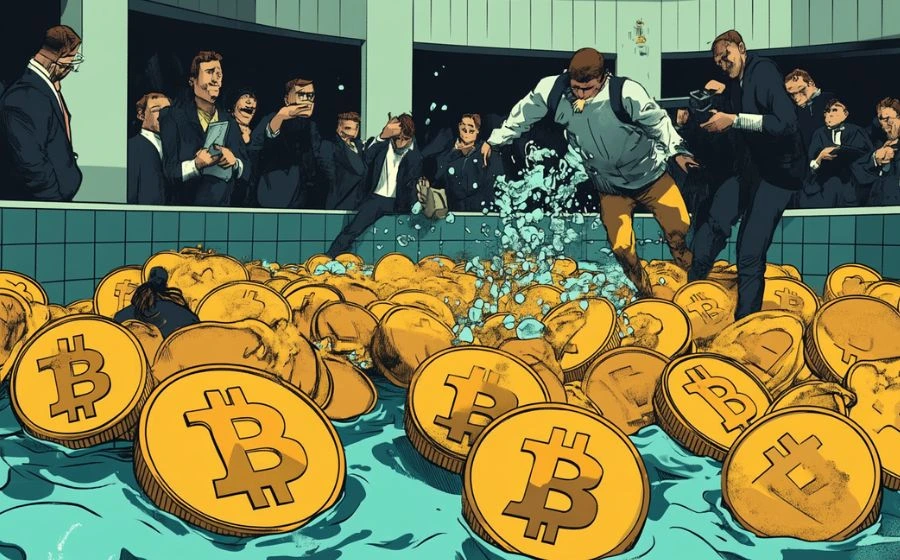
KEYTAKEAWAYS
- DePIN market approaches $2.2 trillion, with 296% year-over-year growth in early-stage funding. By 2028, it's projected to exceed $3.5 trillion in value.
- DePIN offers advantages like cost-effectiveness, speed, and decentralization, making it attractive for various sectors including wireless networks, AI, and data storage.
- Notable DePIN projects include Andrena's decentralized wireless network, Yuliverse's partnership with Moonring for wearable gaming, and Helium's successful IoT infrastructure.

CONTENT
Explore the future of DePIN: $2.2 trillion market, 296% YoY growth. Learn about cost-effective, fast, and decentralized infrastructure networks. Discover key projects like Andrena, Yuliverse, and Helium.
The decentralized physical infrastructure network (DePIN) market continues to see significant growth. According to a report by the tech analysis company Messari, DePIN current valuation approaches $2.2 trillion, the funding for its earliest-stage projects increasing 296% year-over-year, by 2028, the market value of DePIN-related projects is projected to exceed $3.5 trillion.
WHAT IS DEPIN?
DePIN stands for “Decentralized Physical Infrastructure Networks.” The concept of DePIN involves using token rewards as incentives to encourage people to participate in and build real-world physical infrastructure.
For example, the decentralized wireless service Helium Mobile has launched its own telecom service and allows individuals to purchase hotspots to be installed indoors or outdoors, providing network coverage for telecom service customers everywhere. As a hotspot network provider, one can earn token rewards whenever their network is used. Over time, as more people hold hotspots, the network coverage expands, creating a win-win situation.
DePIN will extend the application of Web3 beyond digital assets and decentralized finance, allowing cloud and storage networks, wireless networks, sensor networks, energy networks, and other areas to become more decentralized. This aims to create more resilient, cost-effective, and community-driven alternatives compared to current centralized systems.
Carlos Lei Santos, CEO of wireless network company Uplink, has stated that the market’s urgent need for more wireless hardware connections suggests that new multi-billion-dollar giants are likely to emerge from the DePIN industry.
According to data from Messari and DePIN.Ninjia, as of 2023, there are approximately 650 projects in the DePIN ecosystem, with 250 projects in the computing sector and 200 projects in artificial intelligence. This indicates that DePIN has already started making strides in the AI and data storage technology fields.
>>> Related articles:
THE ADVANTAGE OF DEPIN
As more devices require connectivity services, the efficiency of existing infrastructure is insufficient to meet the demand. This situation is driving the industry’s need for decentralized connectivity solutions. These solutions offer scalability and sustainability, which is crucial for future development.
Advantage 1: Cost-Effective
DePIN provides a more affordable option than traditional infrastructure by significantly reducing the costs of building and maintaining physical structures, and personnel.
Advantage 2: Speed
DePIN enables faster hardware connections to the internet, offering companies flexibility to adapt to rapid market changes and delivering a competitive edge.
Advantage 3: Decentralization
Since DePIN networks are made up of thousands of nodes, rather than a centralized structure managed by one company, they are more resilient to attacks and technical issues.
Despite its benefits, DePIN faces challenges, such as the volatility of token prices. if the value of the token drops, contributors might leave, potentially leading to the collapse of the network.
3 NOTABLEDEPIN PROJECTS
1. Andrena
A Solana-based DePIN project and wireless internet provider, recently secured $18 million in a Series A extension round. This round was led by Dragonfly and saw participation from CMT Digital, Castle Island Ventures, and Wintermute Ventures.
The core of Andrena’s offering is DAWN, which stands for Decentralized Autonomous Wireless Network. Built on Solana’s DePIN protocol, DAWN aims to transform network access similarly to how solar panels have revolutionized electricity. It enables users to own, generate, and sell their own network services, creating a decentralized model for internet access.
The DAWN token plays several roles in this ecosystem. It incentivizes early adopters to deploy network infrastructure and acts as a medium of exchange within the network for transactions such as buying and selling bandwidth. Additionally, it is used to access network resources like bandwidth and IP addresses.
According to the white paper, participants can stake 100,000 DAWN tokens to earn a badge. The cost of these badges will increase progressively within the same geographic area, meaning that each subsequent badge will be more expensive than the previous one. Badge holders will receive 12% of the revenue from all bandwidth transactions within their designated area.
2. Yuliverse and Moonring
Yuliverse has announced a strategic partnership with Moonring, a leader in Data DePIN wearable terminals for gaming.
Moonring’s wearable device collects and analyzes user data, such as movement and activity, which can be utilized within Yuliverse to enhance gaming experiences and potentially generate rewards. This collaboration allows users to earn points through both in-game activities and real-world behaviors, such as fitness and sleep tracking, creating a new layer of interaction between the digital and physical worlds.
This partnership is significant as it pushes Yuliverse further into the DePIN ecosystem, expanding its potential for data-driven applications while ensuring user privacy and data ownership.
3. Helium Network
The Helium Network is a decentralized global wireless infrastructure focused on telecommunications and the Internet of Things (IoT). At its core, Helium leverages blockchain technology to create DePINs by incentivizing individuals to contribute to the network.
Helium’s model allows people to set up wireless Hotspots, which provide network coverage for IoT devices and cellular networks, and in return, Hotspot providers are rewarded with $HNT tokens.
The Helium Network has demonstrated success in various sectors, such as flood detection systems in Porto, Portugal, and environmental monitoring for museums. Its decentralized model has also gained the attention of major telecom companies like Telefónica, which aims to expand Helium’s wireless coverage in underserved areas like rural Mexico. As of now, Helium has over 980,000 active Hotspots, with a market capitalization exceeding $1.4 billion.
Their unique model, where individuals can contribute to building physical infrastructure and get rewarded with tokens, has made Helium one of the most successful decentralized wireless networks in the world.
>>> Related articles:
- DePIN Made Simple | Top 3 DePIN Projects Exclusive – The Wrap of Token2049 Singapore 2023
- TOKEN2049 Singapore 2024: All You Need to Know About the Global Crypto Summit
DEPIN: $2.2T MARKET RESHAPING GLOBAL INFRASTRUCTURE
Decentralized Physical Infrastructure Networks (DePIN) are reshaping the digital landscape, boasting a $2.2 trillion market valuation with projected growth to $3.5 trillion by 2028. This sector’s remarkable 296% year-over-year increase in early-stage funding underscores its transformative potential across industries from telecommunications to AI and data storage.
Key players like Andrena, Yuliverse, and Helium Network demonstrate DePIN‘s practical applications, highlighting its core advantages: cost-effectiveness, speed, and enhanced resilience through decentralization. DePIN extends Web3 beyond digital assets and DeFi, offering efficient, community-driven alternatives to centralized systems.
Despite challenges like token price volatility, DePIN‘s potential to create multi-billion-dollar opportunities is clear. As these technologies mature and adoption grows, we can expect significant shifts in how global networks are built and maintained. The future of physical infrastructure is increasingly decentralized, token-incentivized, and community-powered, promising a more connected and resilient world.

















